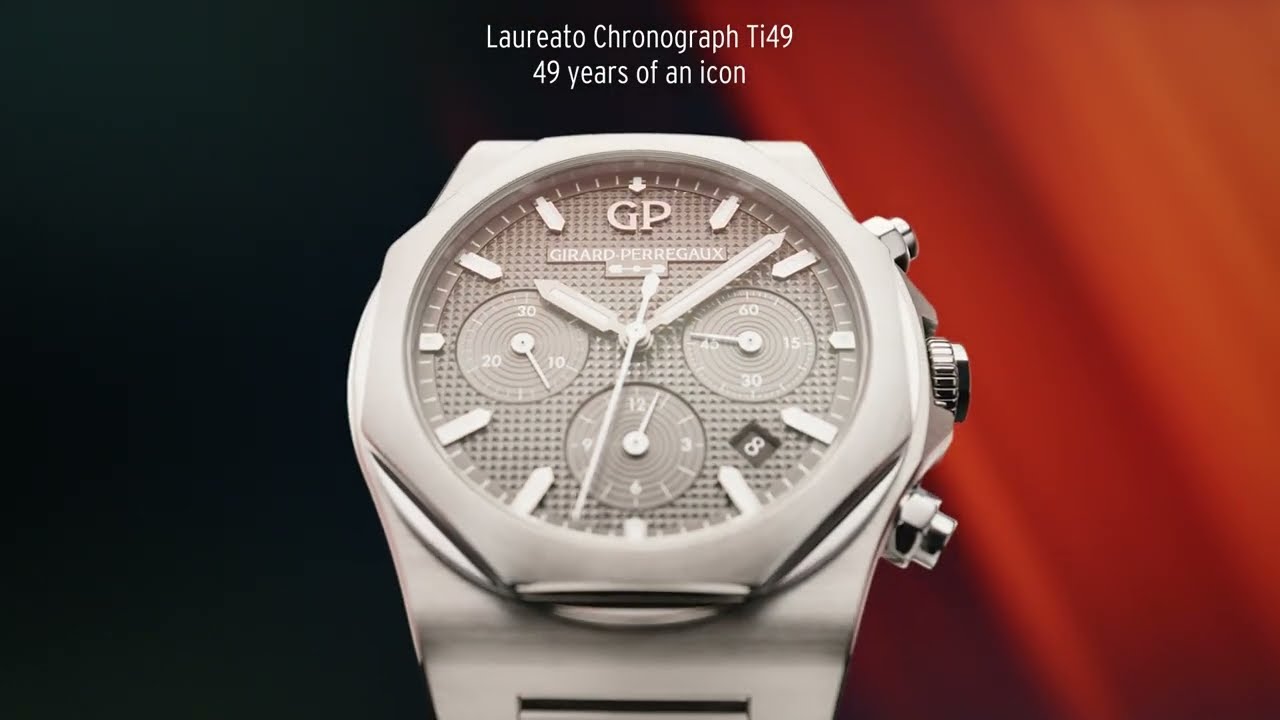La Chaux-de-Fonds, March 19th 2024 (10AM CET) – Girard-Perregaux is pleased to unveil a new expression of the company’s iconic timepiece that burst onto the watch scene back in 1975. The Laureato Chronograph Ti49 unites the model’s intricately-shaped case design with ultra-desirable Grade 5 titanium. This is the first time this strong alloy has featured on a classic Laureato reference. Beyond its strength, this alloy is light, corrosion-resistant and hypoallergenic.
Two remarkable men driven by an innate need to discover, invent and learn
Orphaned at a young age, Jean-François Bautte (1772-1837) had to grow up quickly. He embarked on an apprenticeship at a young age, amassing an incredible understanding of watchmaking as well as several associated trades such as case assembly, guilloché and goldsmithery. In 1791, just 19 years of age, Bautte signed his first watches in the cradle of Swiss watchmaking, Geneva. This event sowed the seeds for what would later become known as Girard-Perregaux, the esteemed Maison based in La Chaux-de-Fonds.

In the same year Bautte signed his inaugural watch, an English clergyman discovered titanium in Cornwall, England. William Gregor (1761-1817) was fascinated with minerals and spent time studying sand deposits in the Manaccan Valley. He was able to isolate calx, formed from heating a mineral. This process left behind an unknown metal. Gregor named the residual metal ‘manaccanite’, a material that later became. Known as ‘titanium’, a name inspired by the great titans of Greek mythology.
The Manaccan Valley is approximately 1400 km from Geneva, yet both Bautte and Gregor were driven by the same innate need to discover, invent and learn.

Grade 5 titanium – introduction
Peruse the periodic table with an outstretched finger, sweeping from left to right, and you will discover, in Period 4, the element Titanium (Ti). In order to isolate titanium in pure form, various processes were developed. The Hunter process was invented in 1910 and thereafter the Kroll process was conceived during the 1930s, a process that is still used today.
Over the years, numerous grades of titanium have been created by legions of specialists, alloying pure titanium with other elements to derive an array of benefits. Titanium alloy 6-4, better known as Grade 5 titanium, was invented in 1951 by Professor Stan Abkowitz. It has since been used in an array of industries, including chemical, medical, marine, firearms, aerospace, etc, as well as for the making of fine timepieces.

Grade 5 titanium is composed of almost 90% titanium, 6% aluminium, 4% vanadium and small traces of iron and oxygen. It is light, strong, stiff, corrosion resistant, non-magnetic and hypoallergenic; all useful attributes for watchmaking.
A further benefit of using this particular form of titanium alloy is that it can be polished to a brilliant gleam, a characteristic that Girard-Perregaux has wonderfully exploited on its latest model, the Laureato Chronograph Ti49.

Grade 5 titanium – making components
Not to be confused with cheaper types of titanium, Grade 5 titanium is both challenging and costly to machine; however, consistent with fine watchmaking, the wearer benefits justify the protracted efforts. It is for this reason that an increasing number of watch brands now refer to this alloy in the same reverential tones as noble metals such as gold and platinum. Paradoxically, the resultant case and bracelet appear warm while simultaneously looking eminently cool.

What’s in a name?
First released in 1975, the ‘Laureato’ was initially called the ‘Quartz Chronometer’. However, in Italy, the most important market for Girard-Perregaux at the time, the model soon became known among the cognoscenti as the ‘the graduate (Laureato in Italian) of the school of Girard-Perregaux’. This affectionate name served as acknowledgement of the model’s prize-wining success and extraordinary precision. Ultimately, the name was adopted by the Maison. Coincidentally, the octagonal bezel sits atop the case, like a laurel crown sits upon the head of a laureate.
With a significant birthday around the corner, Girard-Perregaux celebrates the 49th anniversary of its iconic watch with the release of the Laureato Chronograph Ti49.
The Laureato – never a product of haste
The Laureato Chronograph Ti49 is housed in a 42 mm case and subscribes to the iconic design language first seen on the inaugural model of 1975. The octagonal bezel sits atop a circular plinth which in turn rests upon a tonneau-shaped case. The elaborate profile of the case freely engages with light, courtesy of its many facets and angles, producing pockets of brilliance and shade. Clearly, the historic complexity of making the Laureato’s bezel, case and bracelet are heightened with the use of the Grade 5 titanium used for the first time in the last generation Chronograph.
The hue of this ultra-desirable alloy bestows a warm appearance. Moreover, by using Grade 5 titanium, Girard-Perregaux has also been able to endow the Laureato Chronograph Ti49 with refined, contrasting finishes. Brushed surfaces are juxtaposed with polished highlights. Indeed, the aforementioned circular plinth, the beautifully defined case edges, chronograph pushers as well as the central links of the bracelet are all presented in gleaming form.

The Manufacture has sought to accentuate titanium’s grey hue by embracing a palette of monochromatic shades. The dial is grey and enriched with a Clous de Paris pattern, a feature that will inevitably appeal to brand devotees. Grey PVD-treated baton-style hour and minute hands are teamed with matching baton-type indexes. Both the hands and indexes are lined with white luminescent material and emit a white glow in dim light.
Three snailed counters: a 30-minute chronograph register, a 12-hour chronograph register and a small seconds display, punctuate the textured dial. A date display, located between 4 and 5 o’clock completes the list of functions. The GP logo, name, minute track, as well as the markings encircling the counters, are all executed in white, contrasting wonderfully with the grey coloured dial and aiding readability.

The Manufacture Calibre GP03300 resides within the lightweight exterior of the Laureato Chronograph Ti49. This self-winding movement, comprising 419 components, is beautifully finished. It is adorned with several forms of decoration, including ‘Côtes de Genève’, both in circular and straight form, circular graining, satin finish, chamfering, mirror polishing, snailing, engravings, sunray finish as well as featuring blued steel screws. All types of finishing are skilfully imparted by the Maison’s team of talented craftspeople and watchmakers.
We will never know if Jean-François Bautte heard of William Gregor’s discovery; however, there is no question that 1791 was a remarkable year. It is the work of both men that has ultimately led to the creation of this contemporary watch, a timepiece rich in tradition and brimming with attributes.
The Laureato Chronograph Ti49 will go on sale in March 2024 and will be available worldwide in all Girard-Perregaux retailers.
Girard-Perregaux Laureato Chronograph Ti49 Technical Specifications
Reference 81020-21-3263-1CM
Suggested retail price: CHF 18’600 / USD 19’400 / GBP 16’500 / EUR 20’500
Movement
- Reference: GP03300-0141
- Self-winding mechanical movement
- Diameter: 25.95 mm (111/2’’’)
- Height: 6.50 mm
- Frequency: 28,800 Vib/h – (4 Hz)
- Number of components: 419
- Number of jewels: 63
- Power reserve: min. 46 hours
- Functions: Chronograph, hours, minutes,
- small seconds, date
Case
- Material: titanium, polished and satin finished
- Dimensions: 42.00 mm
- Height: 12.00 mm
- Glass: anti-reflective sapphire crystal
- Case-back: secured by 6 screws
- Dial: grey with a ‘Clous de Paris’ pattern, grey PVD-treated GP logo, ‘baton’-type grey PVD-treated indexes with luminescent material (white emission)
- Hands: ‘baton’ type grey PVD-treated hands with luminescent material (white emission)
- Water resistance: 100 meters (10 ATM)
Bracelet
- Material: titanium, polished and satin finished












About Girard-Perregaux
Since 1791, Girard-Perregaux has been embracing the rhythm of ever-elusive time. Cradled in the Jura mountains in the heart of La Chaux-de-Fonds, it is a pioneer in the world of Haute Horlogerie: an independent Manufacture which has retained this status for over two centuries, successfully keeping all production in-house and passing down exceptional horological skills throughout the generations. The preservation of this savoir-faire, along with a sincere passion for beauty and for the art itself, has remained the key to Girard-Perregaux’s ability to continuously innovate.
Always seeking the perfect balance of beauty and functionality, fans of fine watchmaking will instantly recognise the house signatures, such as the iconic octagonal bezel of the Laureato and the legendary Tourbillon with ‘Three Gold Bridges’. From seeking to create industry references in timepieces to making the invisible visible through the art of precision engineering, Girard-Perregaux never ceases to change the course of time via pieces that are the first of their kind. This place at the vanguard of horological innovation is solidified by over one hundred recorded patents for original designs, like the movement of three arrow-shaped bridges, registered in 1884, as well as prizes like the ’Aiguille d’Or’ in 2013 and distinctions like the Gold Medal at the Paris Universal Exhibition in 1889.
Rooted in its heritage, Girard-Perregaux is driven by the instinct to always look ahead, embracing new technologies, utilising state-of-the-art materials, and finding inventive ways to bring joy by reimagining iconic shapes. To this end, Girard-Perregaux has remained a human-sized Manufacture, and in 2022 became part of an independent collective of Haute Horlogerie Manufactures alongside sister Maison Ulysse Nardin.








